The laser cladding market, valued at USD 633.2 million in 2025, is expected to see robust growth over the next decade, reaching USD 1,749.9 million by 2035, with a CAGR of 10.7%. From 2025 to 2027, the market expands from USD 633.2 million to USD 701.0 million, driven by increasing adoption of laser cladding in industries like aerospace, automotive, and heavy machinery. The technology’s ability to enhance surface properties and improve durability in critical components is fueling demand, with manufacturers seeking more cost-effective, high-performance solutions.
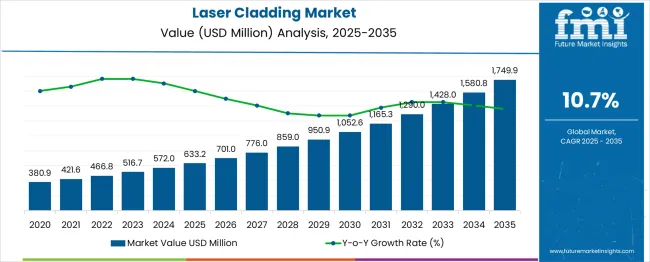
Between 2027 and 2030, the market is expected to continue expanding, growing from USD 701.0 million to USD 859.0 million. During this period, laser cladding is increasingly used in high-precision applications, where improved wear resistance and corrosion protection are essential.
The automotive and energy sectors, in particular, are adopting laser cladding to improve component performance and extend the lifespan of machinery. From 2030 to 2035, the market is expected to experience accelerated growth, reaching USD 1,749.9 million. This phase is driven by advancements in laser cladding technology, wider industrial applications, and growing demand for enhanced coatings in demanding environments.
| Metric | Value |
|---|---|
| Estimated Value in (2025E) | USD 633.2 million |
| Forecast Value in (2035F) | USD 1,749.9 million |
| Forecast CAGR (2025 to 2035) | 10.7 % |
Government regulations, especially those related to environmental impact and manufacturing processes, can significantly influence the market. Stricter environmental policies often push industries towards adopting more efficient and ecological technologies, which, in the case of laser cladding, can lead to increased demand for the technology. Policies promoting cleaner manufacturing processes have supported the growth of laser cladding, as it is a precise and less wasteful method compared to traditional processes. Government incentives aimed at fostering innovation in industries such as aerospace and automotive have contributed to the market expansion, making it more accessible to a wider range of industries.
The market is also sensitive to fluctuations in raw material costs, especially metals and alloys used in the cladding process. Volatility in the prices of these materials can lead to higher production costs, which may be passed on to consumers or result in reduced profitability for manufacturers. Despite this, the laser cladding market has shown strong adaptability. Companies have sought alternatives and optimized their processes to mitigate the effects of material cost fluctuations. The market experiences short-term disruptions due to external shocks, but its long-term growth remains stable, supported by continuous technological advancements and increasing industrial adoption.
Market expansion is being supported by the increasing demand for advanced surface modification technologies and the corresponding need for high-performance coating solutions. Modern manufacturers are increasingly focused on component durability enhancement, wear resistance improvement, and cost-effective repair alternatives that can extend equipment lifecycle. Laser cladding's proven efficacy in providing superior metallurgical bonding and precise material deposition makes it a preferred technology in critical industrial applications.
The growing focus on manufacturing and circular economy principles is driving demand for laser cladding solutions that enable component repair and refurbishment rather than replacement. Industrial preference for technologies that combine precision, efficiency, and environmental benefits is creating opportunities for innovative laser cladding systems. The rising influence of Industry 4.0 trends and automation requirements is also contributing to increased technology adoption across different industrial sectors and applications.
The market is segmented by end user, and region. By end user, the market is divided into OEM, aerospace & defense, oil & gas, automotive, power generation, medical, mining, and others. Regionally, the market is divided into North America, Europe, East Asia, South Asia & Pacific, Latin America, and Middle East & Africa.
The OEM end user segment is projected to account for 59 % of the laser cladding market in 2025, reaffirming its position as the category's primary application area. OEMs increasingly recognize the value of laser cladding in improving component performance, enhancing surface properties, and extending service life while reducing maintenance requirements. The technology’s ability to create strong metallurgical bonds and superior surface characteristics addresses the manufacturing needs for high-performance parts in industries such as aerospace, automotive, and industrial machinery.
As the most scalable and economically viable application of laser cladding, OEM adoption drives technological advancements and industrial validation, boosting confidence in its effectiveness. As manufacturing demands grow for higher-performing components with longer intervals between maintenance, OEM applications align with both operational efficiency and quality enhancement goals, further cementing OEM’s role as the central growth driver of the laser cladding market.
The laser cladding market is advancing rapidly due to increasing industrial demand for surface modification technologies and growing focus on component lifecycle extension. The market faces challenges including high initial equipment costs, technical complexity requirements, and competition from alternative coating technologies. Innovation in automation systems and advanced material development continue to influence technology advancement and market expansion patterns.
The adoption of automated laser cladding systems is accelerating, enabling manufacturers to achieve consistent quality and enhanced process efficiency. Advanced process control systems provide real-time monitoring, precise parameter adjustments, and integrated quality assessment, improving manufacturing reliability. Automation, combined with robotic systems, is particularly beneficial for large-scale manufacturers who require high-throughput, precise coating solutions. These innovations not only streamline operations but also reduce human error, increase output, and optimize overall production efficiency, driving broader industry adoption of automated laser cladding technologies.
Laser cladding manufacturers are increasingly incorporating advanced materials, specialized alloys, and engineered coatings to improve performance and expand application potential. The development of advanced powders and metal compositions enhances the durability, wear resistance, and corrosion properties of the coatings. These material innovations allow for custom solutions tailored to specific industry needs, offering improved functionality in demanding environments. By integrating these advanced materials with laser cladding technologies, manufacturers can deliver high-performance coatings that meet the diverse requirements of sectors such as aerospace, automotive, and energy.
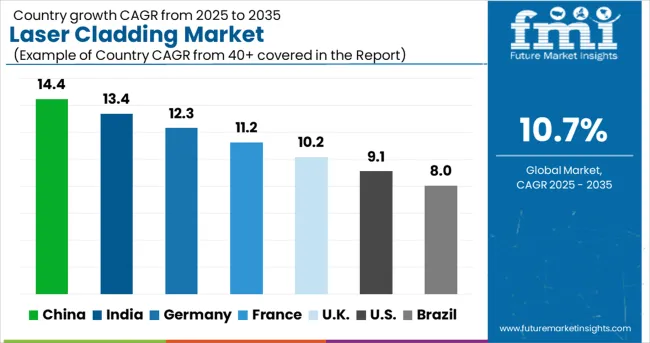
| Countries | CAGR (2025-2035) |
|---|---|
| China | 14.4% |
| India | 13.4% |
| Germany | 12.3% |
| France | 11.2% |
| UK | 10.2% |
| USA | 9.1% |
| Brazil | 8.0% |
The laser cladding market is experiencing robust growth globally, with China leading at a 14.4% CAGR through 2035, driven by rapid industrial expansion, increasing manufacturing sophistication, and growing adoption of advanced surface modification technologies. India follows closely at 13.4%, supported by expanding manufacturing sector, rising industrial automation, and increasing demand for component lifecycle extension solutions. Germany shows steady growth at 12.3%, underscoring precision engineering applications and advanced manufacturing technologies. France records 11.2%, focusing on aerospace applications and high-performance coating solutions. The UK shows 10.2% growth, prioritizing innovation-driven manufacturing and technology development.
The report covers an in-depth analysis of 40+ countries, with top-performing markets highlighted below.
Revenue from laser cladding systems in China is projected to exhibit strong growth with a CAGR of 14.4% through 2035, driven by rapid industrial modernization and increasing adoption of advanced manufacturing technologies among domestic manufacturers. The expanding heavy industries and a focus on increasing manufacturing efficiency are fueling the demand for precision surface modification technologies. Leading industrial and aerospace manufacturers are establishing laser cladding capabilities to meet the rising need for high-performance coatings and repair solutions. Government support for technological innovation and advanced manufacturing initiatives is boosting the adoption of laser cladding systems. The increasing push for industrial automation and smart manufacturing is accelerating the integration of laser cladding technologies into domestic manufacturing practices.
Demand for laser cladding systems in India is expanding at a CAGR of 13.4%, driven by investments in the manufacturing sector and growing sophistication in industrial processes. The aerospace, automotive, and heavy industries are fueling the demand for high-quality surface modification technologies like laser cladding. The market is supported by the growing trend of extending component life and reducing maintenance costs. The manufacturers seek to improve production quality and operational efficiency, the integration of advanced technologies like laser cladding becomes increasingly vital. Both international and domestic players are expanding their service offerings to cater to this rising demand. The trend toward smart manufacturing and technology integration is driving the growth of laser cladding systems across various industrial applications.
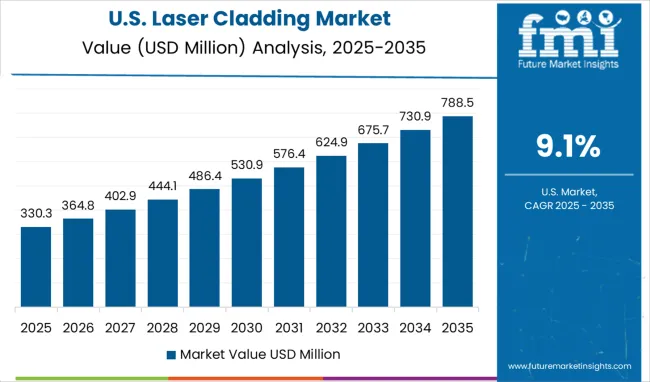
The laser cladding market in the United States is projected to grow at a CAGR of 9.1%. The aerospace and defense sectors remain the primary drivers of this market, where precision applications and performance enhancement are critical. American manufacturers place a premium on high-performance systems, with a focus on automation and quality control in laser cladding applications. The market is characterized by strong demand for cutting-edge technologies that enhance component performance and manufacturing efficiency. Research and development programs continue to advance the technological capabilities of laser cladding systems, ensuring they meet stringent industry standards. These advancements are crucial to maintaining the USA's leadership in precision manufacturing.
Germany is witnessing solid growth in the laser cladding market, with a CAGR of 12.3% through 2035. Renowned for its engineering and precision manufacturing capabilities, Germany has positioned itself as a leader in advanced laser cladding technologies. The country’s commitment to process optimization and high-quality manufacturing has created a strong demand for laser cladding systems that offer precision control and advanced material capabilities. German manufacturers prioritize reliability and performance in their production processes, with laser cladding systems serving as key components in meeting these requirements. Collaboration between industrial equipment manufacturers and research institutions continues to drive innovation, positioning Germany as a dominant player in laser cladding applications.
Revenue from laser cladding systems in France is projected to grow at a CAGR of 11.2% through 2035, supported by strong aerospace industry demand and focus on high-performance manufacturing technologies. French manufacturers focus on precision, advanced materials compatibility, and proven performance, making laser cladding a vital component of advanced manufacturing operations. France’s strong commitment to high-quality manufacturing practices and technological innovation is driving the demand for laser cladding solutions across industrial sectors. The manufacturing excellence, coupled with the rise of specialized laser cladding applications, continues to fuel market growth. The industries seek to enhance performance, reduce maintenance costs, and improve efficiency, laser cladding technology becomes an essential tool.
The laser cladding market in the United Kingdom is projected to grow at a CAGR of 10.2% through 2035, supported by the strong focus on manufacturing innovation, technology development, and advanced industrial applications. The UK’s aerospace, automotive, and industrial equipment industries are major consumers of laser cladding solutions, as manufacturers seek to improve quality and reduce operational costs. The market is bolstered by research institutions that collaborate with manufacturers to advance the capabilities of laser cladding technologies. The UK is investing heavily in automation and smart manufacturing, which are accelerating the adoption of laser cladding systems across various industries . British manufacturers prioritize process efficiency, quality enhancement, and green manufacturing practices, making laser cladding systems a trusted choice in precision manufacturing sectors.
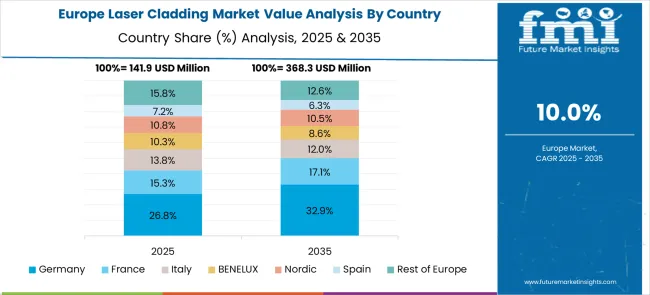
The laser cladding market in Europe demonstrates mature development across major economies with Germany showing strong presence through its advanced manufacturing sector and industrial focus on precision engineering technologies, supported by companies leveraging automotive and aerospace expertise to develop effective laser cladding systems that enhance component performance and manufacturing efficiency.
France represents a significant market driven by its aerospace industry heritage and sophisticated understanding of advanced manufacturing technologies, with companies pioneering precision laser cladding systems that combine French engineering excellence with advanced process control for enhanced component durability and performance optimization.
The UK exhibits considerable growth through its focus on innovation-driven manufacturing and technology development, with companies leading the advancement of automated laser cladding solutions and comprehensive industrial education about surface modification benefits. Germany and Netherlands show expanding interest in advanced manufacturing solutions, particularly in precision laser cladding systems targeting industrial applications and component lifecycle extension. Italy and Spain contribute through their focus on manufacturing excellence and technology integration, while Eastern Europe and Nordic regions display growing potential driven by increasing industrial modernization and expanding access to advanced manufacturing technologies across diverse industrial sectors.
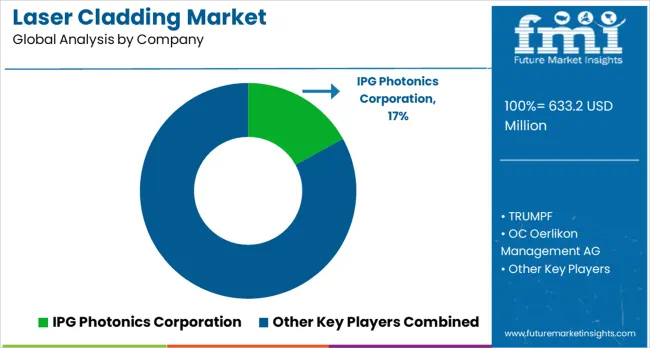
The laser cladding market is highly competitive, comprising established industrial equipment manufacturers, specialized laser technology companies, and emerging automation solution providers. Companies are making significant investments in advanced laser systems, automated process control, precision material handling, and comprehensive service capabilities to deliver efficient, reliable, and effective laser cladding solutions. Innovation in laser technology, application expertise, and superior service delivery are critical to strengthening product offerings and expanding market presence.
Coherent Corp and Jenoptik, both operating globally, offer advanced laser systems across various industrial applications and technology platforms. These companies cater to a wide range of industries, offering flexible and high-performance solutions for laser cladding. Hayden Corp, based in the USA, focuses on specialized cladding services and application development, tailoring solutions to meet specific customer needs. Titanova Inc. provides advanced material solutions, with a particular focus on specialized alloy applications, while Swanson Industries and American Cladding Technologies, Inc. emphasize specialized services for component repair and industrial applications, further expanding the scope of laser cladding services available in the market.
IPG Photonics Corporation, based in the USA, is a market leader with a 17% global value share. The company specializes in advanced fiber laser systems, focusing on precision control and industrial reliability. TRUMPF, a Germany-based company, provides end-to-end laser cladding solutions, emphasizing automation integration and process optimization to enhance operational efficiency. OC Oerlikon Management AG, headquartered in Switzerland, offers specialized coating systems with a focus on advanced materials and in-depth application expertise. Höganäs AB, based in Sweden, is a key player known for its powder materials and comprehensive coating solutions, playing a significant role in enhancing the quality and durability of coated surfaces.
| Items | Values |
|---|---|
| Quantitative Units (2025) | USD 633.2 million |
| End User | OEM, Aerospace & Defense, Oil & gas, Automotive, Power Generation, Medical, Mining, Others |
| Regions Covered | North America, Europe, East Asia, South Asia & Pacific, Latin America, Middle East & Africa |
| Countries Covered | United States, Canada, United Kingdom, Germany, France, China, Japan, South Korea, India, Brazil, Australia and 40+ countries |
| Key Companies Profiled | IPG Photonics Corporation, TRUMPF, OC Oerlikon Management AG, Höganäs AB, Coherent Corp, Jenoptik, Hayden Corp, Titanova Inc, Swanson Industries, and American Cladding Technologies, Inc. |
| Additional Attributes | Revenue analysis by technology type and application sector, regional demand trends, competitive landscape, customer preferences for equipment versus service solutions, integration with automation and process control systems, innovations in powder materials, process optimization, and green manufacturing practices |
The global laser cladding market is estimated to be valued at USD 633.2 million in 2025.
The market size for the laser cladding market is projected to reach USD 1,749.9 million by 2035.
The laser cladding market is expected to grow at a 10.7% CAGR between 2025 and 2035.
The key product types in laser cladding market are oem, _aerospace & defense, _oil & gas, _automotive, _power generation, _medical, _mining, _others, smes, _equipment, _material and _services.
In terms of , segment to command 0.0% share in the laser cladding market in 2025.






Our Research Products

The "Full Research Suite" delivers actionable market intel, deep dives on markets or technologies, so clients act faster, cut risk, and unlock growth.

The Leaderboard benchmarks and ranks top vendors, classifying them as Established Leaders, Leading Challengers, or Disruptors & Challengers.

Locates where complements amplify value and substitutes erode it, forecasting net impact by horizon

We deliver granular, decision-grade intel: market sizing, 5-year forecasts, pricing, adoption, usage, revenue, and operational KPIs—plus competitor tracking, regulation, and value chains—across 60 countries broadly.

Spot the shifts before they hit your P&L. We track inflection points, adoption curves, pricing moves, and ecosystem plays to show where demand is heading, why it is changing, and what to do next across high-growth markets and disruptive tech

Real-time reads of user behavior. We track shifting priorities, perceptions of today’s and next-gen services, and provider experience, then pace how fast tech moves from trial to adoption, blending buyer, consumer, and channel inputs with social signals (#WhySwitch, #UX).

Partner with our analyst team to build a custom report designed around your business priorities. From analysing market trends to assessing competitors or crafting bespoke datasets, we tailor insights to your needs.
Supplier Intelligence
Discovery & Profiling
Capacity & Footprint
Performance & Risk
Compliance & Governance
Commercial Readiness
Who Supplies Whom
Scorecards & Shortlists
Playbooks & Docs
Category Intelligence
Definition & Scope
Demand & Use Cases
Cost Drivers
Market Structure
Supply Chain Map
Trade & Policy
Operating Norms
Deliverables
Buyer Intelligence
Account Basics
Spend & Scope
Procurement Model
Vendor Requirements
Terms & Policies
Entry Strategy
Pain Points & Triggers
Outputs
Pricing Analysis
Benchmarks
Trends
Should-Cost
Indexation
Landed Cost
Commercial Terms
Deliverables
Brand Analysis
Positioning & Value Prop
Share & Presence
Customer Evidence
Go-to-Market
Digital & Reputation
Compliance & Trust
KPIs & Gaps
Outputs
Full Research Suite comprises of:
Market outlook & trends analysis
Interviews & case studies
Strategic recommendations
Vendor profiles & capabilities analysis
5-year forecasts
8 regions and 60+ country-level data splits
Market segment data splits
12 months of continuous data updates
DELIVERED AS:
PDF EXCEL ONLINE
Cobalt Based Laser Cladding Powder Market Size and Share Forecast Outlook 2025 to 2035
Laser Frequency Splitting and Mode Competition Teaching Instrument Market Size and Share Forecast Outlook 2025 to 2035
Laser Component Analyzer Market Size and Share Forecast Outlook 2025 to 2035
Laser-Assisted Smart Lathes Market Size and Share Forecast Outlook 2025 to 2035
Laser Drilling Equipment Market Size and Share Forecast Outlook 2025 to 2035
Laser Transverse Mode Teaching Instrument Market Forecast and Outlook 2025 to 2035
Laser Welding Equipment Market Forecast and Outlook 2025 to 2035
Laser Welding Market Size and Share Forecast Outlook 2025 to 2035
Laser Ablation Systems Market Size and Share Forecast Outlook 2025 to 2035
Laser Measurement Integrating Sphere Market Size and Share Forecast Outlook 2025 to 2035
Laser Safety Cloths Market Size and Share Forecast Outlook 2025 to 2035
Laser Dazzler Market Size and Share Forecast Outlook 2025 to 2035
Laser Cable Marking Market Size and Share Forecast Outlook 2025 to 2035
Laser Marking Equipment Market Size and Share Forecast Outlook 2025 to 2035
Laser Cutting Machines Market Size and Share Forecast Outlook 2025 to 2035
Laser Wire Marking Systems Market Size and Share Forecast Outlook 2025 to 2035
Laser Photomask Market Size and Share Forecast Outlook 2025 to 2035
Laser Measuring Instrument Market Size and Share Forecast Outlook 2025 to 2035
Laser Welding Machine Market Size and Share Forecast Outlook 2025 to 2035
Laser Technology Market Size and Share Forecast Outlook 2025 to 2035

Thank you!
You will receive an email from our Business Development Manager. Please be sure to check your SPAM/JUNK folder too.
Chat With
MaRIA